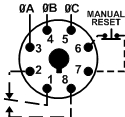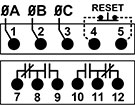Advantages of Macromatic Three-Phase Monitor Relays with Remote Manual Reset
As standard, most three-phase monitor relays have automatic reset. When a fault that has caused the unit to trip is removed, the relay will automatically reset to the normal mode. There are two reasons why this is the preferred reset mode in most applications: first, sometimes the installation is at a remote site and this avoids someone driving miles to simply reset the three-phase monitor relay. Second, there are other control circuit designs such as three-wire control to prevent the load from automatically starting even after the three-phase monitor relay has reset itself.
However, there are times from a safety or preventative maintenance point of view that the application does require a manual reset mode. For example, the situation requires someone to check out why the three-phase monitor relay tripped to prevent additional damage to the motor. It could prevent injury if someone is checking on the installation and the motor restarts automatically. In any case, an operator must initiate some action before the phase monitor relay will reset. There are typically two ways to offer manual reset mode on these products: a top-mounted button or two terminals for connection to a remote reset button.
The disadvantage of a relay with a top-mounted button is that the operator must open the enclosure and reach in to access the button. Not only do they have to unlock and open the door, but they are then reaching into an area where high voltage circuits exist. And with today’s arc flash requirements, who wants to dress up in an arc flash suit to simply reset a three-phase monitor relay?
The better solution is to use three-phase monitor relays from Macromatic. All PMP Series plug-in (except the PJPU-FA8X, PMPU-FA8X & PMPU-FA12X) and PMD Series DIN-rail mounting phase monitor relays offer remote manual reset mode. These products have two terminals dedicated to the manual reset mode. Here’s how they work:
On initial power-up, the unit will check the status of terminals 6 & 7 on plug-in products or terminals 4 & 5 on the DIN-rail mounted versions (see wiring diagrams below). If there is no connection across these terminals, the relay will operate in the Automatic Reset mode. However, they can be set in the Manual Reset mode by connecting an external N.C. switch across these two terminals. Upon application of line voltage, the relay will go into the Manual Reset mode if it recognizes a closure across these two terminals. After a fault clears, the relay will not reset until the N.C. switch is opened.
|
Plug-in |
DIN-rail |
All Macromatic three-phase monitor relays with the remote manual reset have two advantages over those products with top-mounted buttons:
- They allow the use of a remote pushbutton to manually reset the relay that can be mounted on the outside of the enclosure or even some distance away from the enclosure. This eliminates the need to open the enclosure door and reach in where high voltage circuits exist. It eliminates the need to use arc flash suits when opening the enclosure door.
- While some other brands require a different catalog number to order a phase monitor relay with manual reset, all Macromatic products have this feature as standard. No need to order special versions that may not be stocked at local & national distributors.
For more information, click here or contact Macromatic Technical Support at 800-238-7474.
Recent Articles for:
Blog
- Apr2022 Use Our Competitive Cross Reference to Find Replacement Relays
- Apr2022 New TE-6 Series Single Function Time Delay Relays
- Nov2021 Control, Monitor and Protect - Updated Product Selection Guide
- Nov2021 PBDU Phase Monitor Relays: Save Space, Quick Installation and Reduced Costs.
- Oct2021 Quick, Safe Connections with Jumpers and Separators on Macromatic Relays


